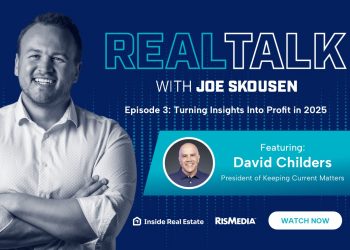By Jennifer Mann
RISMEDIA, August 5, 2008-(MCT)-There are almost 100 million consumers in the United States who are age 50-plus. They control more than $8 trillion in assets, more than 70% of the disposable dollars in the United States.
Yet they barely get passing notice from American advertisers.
Indeed, this wide-ranging group of consumers-the fastest-growing and wealthiest demographic in the United States-spends billions each year on travel, electronics, automobiles, apparel and much more. Often those purchases are made in spite of marketers’ and ad agencies’ best efforts to ignore them.
Instead, the makers and marketers of those goods and services, collectively spending billions each year trying to get consumers to want their stuff, remain fixated on the 18-to-49 demographic-an obsession which, ironically, started in the mid-1960s with the leading edge of the baby boomers.
“If an alien landed on our planet and sized up our market, they’d quickly see that it’s the biggest and fastest-growing group, and yet why marketers want to ignore them is beyond me-but they do,” said Steve Bernstein, president and chief operating officer of ad agency Bernstein-Rein.
Some see an enormous opportunity slipping past those who sell the things with which we define our lives.
More than half of the cars sold in the U.S. each year are purchased by people 50 years or older, but only 10% of auto ad budgets are spent touting cars to that age bracket.
A quarter of Vespa scooters are bought by that 50-plus consumer, but virtually zero marketing dollars are spent on that segment.
The same goes for iPods. Even though the latest data show consumers 45 and up own 19% of iPods, virtually none of Apple’s skimpy iPod ad budget is directed toward anyone beyond the age of 35.
Not surprisingly, preconceptions are often misconceptions. For instance, one reason marketers say they are fixated on the 18-to-49 consumer, or some subset thereof, is that they’re not as brand loyal. They say their marketing dollars are better spent persuading people not set in their ways.
Yet recent data from Focalyst, a marketing and research firm, reveal that, at least among baby boomers between the ages of 44 and 62, 61% say “in today’s marketplace, it doesn’t pay to be loyal to one brand”-almost identical to the 62% of those ages 18 to 41.
Even when marketers successfully sell to the 50-plus consumer, they’re sometimes baffled. Take the case of Honda with the Element, which it spun as a “dorm on wheels,” clearly targeted at a 20-something demographic.
When Honda sold more units than it initially projected, it analyzed sales data and found the average age of an Element buyer was 44.7 years old.
“They were horrified,” said Chuck Nyren, author of Advertising to Baby Boomers. “They went back and tried to figure out what they did wrong.”
Nyren said he often hears from marketers that advertising isn’t effective on those 50-plus consumers, that it’s a waste of time and money.
No, he said, they’re just not doing it correctly.
“Speaking to the 50-plus, it has to be different in terms of writing and graphics and presentation,” Nyren said. “A 20-something is an easier sell-you have to work harder, work smarter to get that 50-plus customer, but the return on investment, if you do it right, can be tremendous.”
When Fairway resident Marcia Nana, who is 60, and her husband bought a new Lexus four years ago, it wasn’t marketing that got their attention. It was their diligent research that led them to make such a purchase after years of buying other nameplates, including Land Rovers and Jaguars.
“I certainly don’t remember any ads that led us to Lexus,” Nana said.
Nyren said a big problem in the ad agency world is that so many employees of agencies, particularly those who work on the creative side, are mostly in their 20s and 30s. Either they have no interest in working on campaigns targeted to older people, or they don’t know how to.
“I can just see it now,” Nyren said. “Ad agencies are going to get all this pressure to market to 50-plus consumers and they’re going to have all these 20-something creatives working on it; it’s going to fail and then they’re going to say, ‘See, we told you! It doesn’t work.'”
Bernstein said the accusation of too many young creative types is often, and usually correctly, lodged against agencies. “But if we hire smart creatives, it shouldn’t be a problem.”
Bernstein said his agency is increasingly moving away from demographics and toward psychographics-the study of personality, values, attitudes, interests and lifestyles.
“We’re not living out our lives like our parents and grandparents,” Bernstein said. “A 50-year-old today may be the parent of a baby, they may be an empty nester, or they may have never had kids. Some 50-year-olds may connect more closely with someone who’s 30 than someone who’s a year younger than themselves.”
Susan Bergman, an analyst with Marigny Research Group, recently wrote a report on the 50-plus market and is compiling one on millennials, those born from 1980 through 1994.
Bergman and other experts said there is tremendous value in advertising to the 18-to-49 demographic. Indeed, there’s value in all demographic groups, Bergman said. But she said there is peril in focusing on one at the expense of another.
“Every demographic group has needs, and sometimes those needs cross many demographics,” Bergman said. “Someone starting out in life with a new spouse and a new baby, they obviously have a lot of needs, but so does everyone throughout their lives-those needs don’t stop at 50.”
Of course, some marketers-think denture makers and funeral homes-enthusiastically embrace the 50-plus consumer. Among those is Crown Media, which is owned by Hallmark Cards Inc. and which owns and operates the Hallmark Channel.
Before Henry Schleiff came on board in late 2006 as chief executive of the Hallmark Channel, the company used to talk around its viewer demographics, seeming a bit embarrassed by the age of its viewers.
But Schleiff unapologetically embraces the channel’s baby boomer audience.
Earlier this year, Schleiff told Wall Street and Madison Avenue that viewers of the Hallmark Channel are not only older, they are also wealthier. And they are more ingrained and more engaged in their TV viewing habits than the oh-so-elusive millennial demographic, currently 14 to 28.
“Our viewers have assets, not allowances,” Schleiff told Wall Street analysts.
Schleiff isn’t that far off the mark. Twenty-five percent of Americans age 18 to 34 still live with their parents, and 62% of college students say they expect to move back in after they graduate.
Some marketers are trying to cross the divide with ageless marketing. One company that’s done so successfully in the past is New Balance, best known for its running shoes.
New Balance racked up growth at a time when others were seeing their market share decline. Between 1999 and 2001, New Balance’s share grew from 3% to 10%, while Nike’s dropped from 48% to 43% and Reebok’s from 15% to 12%.
New Balance achieved that in part by offering five shoe widths to serve a wide range of customers. It used no celebrity endorsers, who might pigeonhole a demographic.
Some in the inner circle of media, including at CBS, where viewers tend to skew older, are beginning to get fed up with the 18-plus obsession.
After catching a reference to the “upscale 18-34” demographic at a media conference in New York, CBS chief executive officer Leslie Moonves derided the idea.
“The only upscale 18-year-olds I know are my children, and they have to come to me if they want to buy a car,” Moonves said.
It’s a ludicrous notion “that they’re the ones with the discretionary income,” he said, “and the 50-year-old is thrown in the garbage. It’s one of the great old wives’ tales.”
© 2008, The Kansas City Star.
Distributed by McClatchy-Tribune Information Services.










